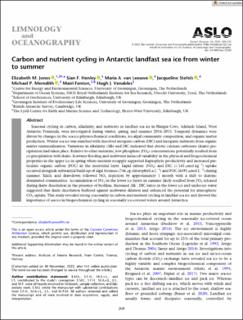| dc.description.abstract | Seasonal cycling in carbon, alkalinity, and nutrients in landfast sea ice in Hangar Cove, Adelaide Island, West Antarctic Peninsula, were investigated during winter, spring, and summer 2014–2015. Temporal dynamics were driven by changes in the sea-ice physicochemical conditions, ice-algal community composition, and organic matter production. Winter sea ice was enriched with dissolved inorganic carbon (DIC) and inorganic nutrients from organic matter remineralization. Variations in alkalinity (Alk) and DIC indicated that abiotic calcium carbonate (ikaite) precipitation had taken place. Relative to other nutrients, low phosphate (PO4) concentrations potentially resulted from co-precipitation with ikaite. Seawater flooding and meltwater induced variability in the physical and biogeochemical properties in the upper ice in spring where nutrient resupply supported haptophyte productivity and increased particulate organic carbon (POC) in the interstitial layer. Rapid nitrate (NO3) and DIC (< 165 μmol kg−1) uptake occurred alongside substantial build-up of algal biomass (746 μg chlorophyll a L−1) and POC (6191 μmol L−1) during summer. Silicic acid drawdown followed NO3 depletion by approximately 1 month with a shift to diatom-dominated communities. Accumulation of PO4 in the lower ice layers in summer likely resulted from PO4 released during ikaite dissolution in the presence of biofilms. Increased Alk : DIC ratios in the lower ice and under-ice water suggested that ikaite dissolution buffered against meltwater dilution and enhanced the potential for atmospheric CO2 uptake. This study revealed strong seasonality in carbon and nutrient cycling in landfast sea ice and showed the importance of sea ice in biogeochemical cycling in seasonally ice-covered waters around Antarctica. | en_US |
